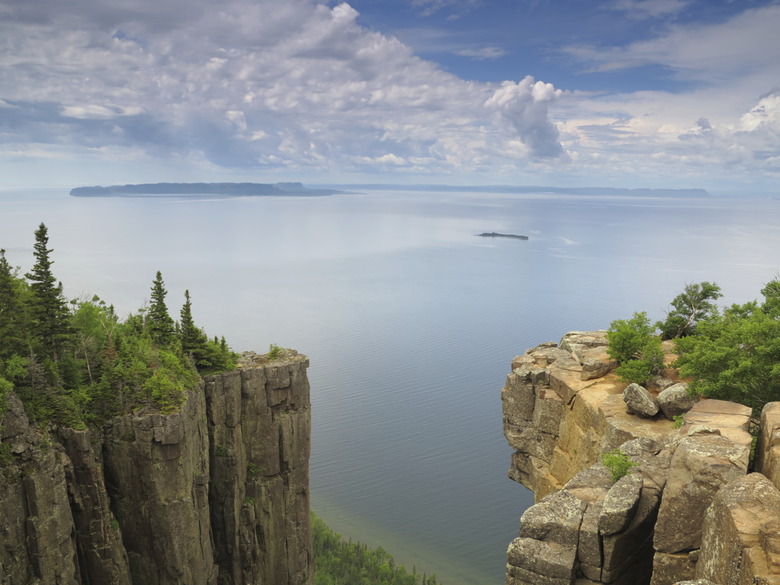Animals & Plants In Lake Superior
Lake Superior, one of the Great Lakes of North America, earns its name. As the largest freshwater lake in the world, it could cover both North America and South America in a foot of water. Hosts of plant and animal life make up the lake's diverse ecology. Unfortunately, in addition to native species, invasive, non-native species also reside in the lake and pose a problem to its ecosystem.
Native Fish in Lake Superior
With so much water, it's no wonder that Lake Superior hosts a great many fish species, including varieties of trout, perch and shiners. Many species of sculpins live in the lake as well, including the deepwater sculpin, a mostly nocturnal fish that feeds at the bottom. Lake Superior is also home to the strange burbot, whose long body earned it the alternative name of eelpout. Active in the winter, the burbot spawns before the ice even melts.
Other Animals in Lake Superior
In addition to fish, many other aquatic creatures call Lake Superior home. Tiny zooplankton, such as waterfleas, copepods and rotifers, feed on each other as well as on phytoplankton. These creatures make up part of the bottom of the food chain, feeding larger and more complex animals. Other tiny invertebrates also live in the lake, including mayfly nymphs and chironomids, whose presence is a marker of good water conditions, as well as snails, clams, amphipods and shrimp. These tiny animals include both native and non-native species, some of them introduced to Great Lake waters by ships and boats.
Plants in Lake Superior
Wetlands along the coasts of Lake Superior include many poor fens, a specific type of wetland characterized by acidic, sandy soils and an extreme northern climate. Decomposition rates are slow in a poor fen. There, flora such as carnivorous pitcher-plants, buckbean, marsh St. John's-wort and bog rosemary flourish. Marshes also occur around Lake Superior, and plants found there may include types of bulrush, marsh bell-flower and blue-joint grass. Shrub-like plants, such as meadowsweet and meadow willow, may grow there as well.
Invasive Species
Lake Superior is also home to many non-native, invasive species, some of which threaten the lake's ecology. One of the most notorious of these is the sea lamprey, a jawless parasite that originated from the Atlantic Ocean. Sea lampreys are such aggressive and effective predators that, in some cases, only one of seven fish survive their attacks. Other non-native animals include the rusty crayfish, quagga and zebra mussels, and the rainbow smelt. Zebra and quagga mussels compete with native mussels, severely reducing their numbers and even causing extinctions. There are invasive plants too, notably Eurasian watermilfoil, whose submerged tendrils form dense clumps that are disruptive to recreational activities such as fishing and boating.
References
Cite This Article
MLA
Michelle, Meg. "Animals & Plants In Lake Superior" sciencing.com, https://www.sciencing.com/animals-plants-lake-superior-7329937/. 24 April 2017.
APA
Michelle, Meg. (2017, April 24). Animals & Plants In Lake Superior. sciencing.com. Retrieved from https://www.sciencing.com/animals-plants-lake-superior-7329937/
Chicago
Michelle, Meg. Animals & Plants In Lake Superior last modified March 24, 2022. https://www.sciencing.com/animals-plants-lake-superior-7329937/
